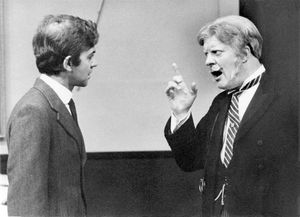Doctor Angelus (1973)

by James Bridie
Produced by Rita M. Tootill
Performances: Sun 14th – Sat 20th October 1973, Theatre
Contents
Introduction
Scene a doctor's consulting room, 1920s.
Act 1 An autumn evening, 9pm
Act 2 Scene 1 - Two weeks later, about 9am. Scene 2 - That night, about 11pm
Act 3 The next morning, 10am
There was a 15-minute interval between acts.
Cast
- Dr Johnston - Roger Dettmer
- Dr Angelus - William Curd
- Jeanie - Vivienne Miles
- Mrs Corcoran - Brenda Maughan
- Mrs Angelus - Sheila Rees
- Sir Gregory Butt - Arthur Skinner
- Inspector MacIvor - D'Auvergne Barnard
- Policeman - Ray Seaton
Crew
- Stage Manager - Ray Seaton
- Lighting - Colin Stokes
- Sound - Jim Judd
- Set Design - Rita M. Toothill
- Set Construction - Ray Seaton & Jim Judd
- Properties - Bob Grice & Jean Warboyes
- Wardrobe - Iris Lenny & Janet Blackley
- Prompt - Brian Scoltock
- Front of House & Box Office - Frank Howcutt
Reviews
"SLTC's Dr Angelus is alive and unwell and dying in West Norwood"
It could be argued that James Bridie's plays, like some wines, are not good travellers.
Certainly performances down in this part of the world are few and far between. We should therefore, at least in theory, be grateful to the South London Theatre Centre for staging (until 20th October) one of his most atmospheric pieces.
But theoretical gratitude is soon dispelled by the chill wind of practical experience. This, the second production of the new season, sharply raises the question: what is the SLTC for? If the answer is merely to add another amateur drama society to the numbers, well and good. But I have always understood that there was more to it than that. If the SLTC deserves to survive, it should be a shining example of a dedicated theatre group, offering the next best thing to a professional company.
On that basis Rita M. Toothill's production of "Dr Angelus" is hardly out of the stalls, let alone in the frame. To stay with the horse-racing analogy, it is hard to realise that it comes from the same stable as, for example, SLTC's "Close the Coalhouse Door" and "Staircase".
Like the author, Dr Angelus is a Scottish doctor. There the resemblance ends, for he is also a cold-blooded murderer with the twisted logic of a fanatic. The play is full of traps for the unwary, but most of them can be overcome if the style is at least consistent. The text is often laboured and repetitious, but there is also much subtlety in the writing.
If the actors cannot command this subtlety, it will stand playing as crude melodrama. In this production we find actors caught between two stools, all doing their own thing and contributing to a stylistic mix-up.
As Dr Angelus, William Curd crosses his arms, frowns a lot and telegraphs his villainy by a mixture of baffled rage and transparent bonhomie. It must in fairness be added that he stepped into the cast at short notice.
English accents predominate, the only exceptions being the ferocious Caledonian vowels of Arthur Skinner, hamming it up as Sir Gregory Butt, and those of D'Auvergne Barnard as the Inspector, who seems poised around the Irish Sea.
One scene between Vivienne Miles and Sheila Rees, as maid and mistress, seems lifted out of one of those medieval witch dramas we find acted in the women's institutes. Unintended humour brings gales of laughter at several times.
Send not to know for whom the bell tolls; it tolls for the SLTC.
Donald Madgwick, the Croydon Advertiser.
"Below Standard"
The South London Theatre Centre's latest offering was certainly not up to their usual high standard.
Admittedly the set for their production of James Bridie's "Dr Angelus" at their West Norwood High-street, West Norwood, theatre, was realistic and well designed by Rita Toothill and made by Ray Seaton and Jim Judd.
Make-up was also good - when someone was supposed to be dying of antimony poisoning, they really looked ill.
But I'm afraid that one got the impression throughout the play that it was dreadfully under-rehearsed. The players often seemed to stand like wooden idols, while chanting lines at each other.
I did feel that a little more attention to detail was also needed. During the first act at least, the actors often did not seem to make the right reaction to things that were said or done.
But perhaps William Curd should be given some praise for his portrayal of Dr Angelus. He made the evil doctor a quiet-spoken and apparently mild-mannered man to bring out the sinister side of the character.
Uncredited newspaper review.
Gallery
- Photo by Bim Harding
- DrAngelus011.jpg
Reminiscences and Anecdotes
Members are encouraged to write about their experiences of working on or seeing this production. Please leave your name. Anonymous entries may be deleted.
See Also
Have there been other SLTC/SLT productions of this play? Link to them here.
Or add anything that is related within this site. The author's page for instance or other plays with a similar theme.
References
<references/>

